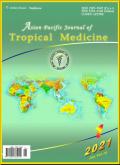儿童单纯疱疹脑炎的自身免疫并发症和临床结果:一个病例系列
IF 1.6
4区 医学
Q3 PUBLIC, ENVIRONMENTAL & OCCUPATIONAL HEALTH
引用次数: 0
摘要
目的:报道16例儿童单纯疱疹病毒性脑炎的神经系统预后及自身免疫性并发症。方法:研究于2017年6月至2019年8月在土耳其Şanlıurfa培训与研究医院进行。该研究包括16例儿童患者,年龄在6个月至17岁之间(中位年龄77.7个月),他们被儿科传染病和儿科神经病学诊所诊断为单纯疱疹病毒1型脑炎。通过患者记录、儿科神经病学诊所的访谈或电话对患者进行跟踪。对临床和人口学资料、接受的治疗、神经预后和并发症进行评估。结果:比较自身免疫性脑炎患者与非自身免疫性脑炎患者的年龄、性别、治疗前症状持续时间、初始脑脊液蛋白、血糖、红细胞计数、白细胞计数,但无显著差异。4例患者出现自身免疫性并发症。3例患者出现n -甲基- d -天冬氨酸脑炎,1例患者出现舞蹈病。平均随访48.3个月。25%的患者接受多种抗癫痫药物(AED)治疗,43.8%的患者接受单一抗癫痫药物治疗,31.3%的患者在随访结束时未接受AED治疗。12.5%的患者有运动障碍,6.3%的患者有耐药癫痫。结论:癫痫和运动障碍可通过免疫治疗得到控制,应常规检测自身抗体。在发现自身免疫性并发症后,应通过随访检测自身抗体水平和临床检查结果尽早开始治疗。为了避免单纯疱疹病毒脑炎的并发症,需要有效的预防和治疗方法。本文章由计算机程序翻译,如有差异,请以英文原文为准。
Autoimmune complications and clinical outcomes of herpes simplex encephalitis in children: A case series
Objective: To report the neurologic prognosis and autoimmune complications of 16 cases of childhood herpes simplex virus encephalitis. Methods: The study was conducted at Şanlıurfa Training and Research Hospital, Turkey from June 2017 to August 2019. The study included 16 pediatric patients aged between 6 months and 17 years (median age 77.7 months) who were diagnosed with herpes simplex virus type 1 encephalitis by pediatric infectious disease and pediatric neurology clinics. Patients were followed using patient records, and interviews at the pediatric neurology clinic or via the telephone. Clinical and demographic data, received therapies, neurologic prognosis and complications were evaluated. Results: Patients with and without autoimmune encephalitis were compared in terms of age, sex, symptom duration before treatment, initial cerebrospinal fluid protein, glucose, red blood count and white blood count but no significant difference was found. Autoimmune complications were seen in four patients. N-methyl-D-aspartate encephalitis was observed in three patients and choreoathetosis was seen in one patient. The average follow-up period was 48.3 months. Twenty-five percent of the patients were receiving multiple antiepileptic drug (AED) treatment, 43.8% were receiving single AED treatment and 31.3% were not receiving AED treatment at the end of the follow-up. Motor disability was observed in 12.5% and drug-resistant epilepsy was observed in 6.3% who had autoimmune complications. Conclusions: Seizures and movement disorders were controlled with immunotherapy and autoantibodies should be studied routinely. Treatment should be started early upon recognition of autoimmune complications through follow-up by measuring autoantibody levels and clinical examination results. Effective prevention and curative treatment modalities are needed to avoid herpes simplex virus encephalitis complications.
求助全文
通过发布文献求助,成功后即可免费获取论文全文。
去求助
来源期刊

Asian Pacific journal of tropical medicine
PUBLIC, ENVIRONMENTAL & OCCUPATIONAL HEALTH-TROPICAL MEDICINE
CiteScore
4.00
自引率
9.70%
发文量
1936
审稿时长
3-8 weeks
期刊介绍:
Asian Pacific Journal of Tropical Medicine (ISSN 1995-7645 CODEN: APJTB6), a publication of Editorial office of Hainan Medical University,is a peer-reviewed print + online Monthly journal. The journal''s full text is available online at http://www.apjtm.org/. The journal allows free access (Open Access) to its contents and permits authors to self-archive final accepted version of the articles on any OAI-compliant institutional / subject-based repository.
APJTM aims to provide an academic communicating platform for international physicians, medical scientists, allied health scientists and public health workers, especially those of the Asia-Pacific region and worldwide on tropical medicine, infectious diseases and public health, and to meet the growing challenges of understanding, preventing and controlling the dramatic global emergence and re-emergence of infectious diseases in the Asia-Pacific.
The journal is proud to have an international and diverse editorial board that will assist and facilitate the publication of articles that reflect a global view on tropical medicine, infectious diseases and public health, as well as emphasizing our focus on supporting the needs of public health practitioners. The APJTM will allow us to seek opportunities to work with others who share our aim, and to enhance our work through partnership, and to uphold the standards of our profession and contribute to its advancement.
 求助内容:
求助内容: 应助结果提醒方式:
应助结果提醒方式:


